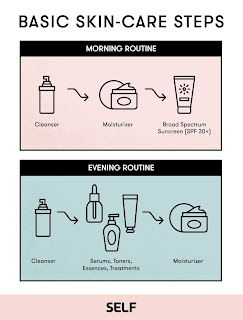What is My Skin Type? Part 2
- Get link
- X
- Other Apps
Hello again :) This follows my previous blog where I introduced you to different skin types and a basic routine.
How to identify your skin type?
There are a few methods, one is just looking at your face throughout the day and checking its condition e.g. is it oily or dry? And whereabouts? But if you don’t have time to check all day, another method involves:
- After cleansing, do not apply any products for up to 30 minutes
- During this time, observe the oil production levels (if any) on your face, and match with the corresponding skin types below
- OR after waiting, use blotting papers and place them on each section of your face e.g. cheeks, forehead, nose, chin, and observe the amount of oil it absorbed. Again, match with the corresponding skin types below.
Normal: has a balanced water-oil proportion, no flakiness
nor excess oil. Skin looks smooth, pores are of minimal size and less likely
prone to breakouts. Blotting paper will probably have minimal oil too.
Dry: lacks oil which can cause rough, flaky and/or scaly
skin. It may also feel tight and dehydrated if it lacks water. It is more prone
to visible lines and irritation. Blotting paper will have little to no oil.
Oily: produces excess oil, resulting in oily, shiny and/or
greasy skin. It is more nourished in a way but this means it is prone to acne
and breakouts, and enlarged and clogged pores. Blotting paper should absorb a
lot of oil on the whole face.
Combination: typically has properties of dry or normal skin on the cheeks and properties of oily skin on the T-zone (forehead, nose and chin – the shape of a T on your face). This skin type can be harder to look after because of the two different skin types. Blotting paper should be oily on the T-zone and minimal everywhere else i.e. the cheeks.
(Paula's Choice, 2021) (CeraVe,
2021)
Fun fact: I had dry skin my whole life and until my late teens, it became more combination. Not sure the reason but maybe it’s because I started to drink more water…and that’s a reminder to stay hydrated at all times!
I hope this helps you to find out what your skin type is! Still confused? This video is helpful and explains it in more detail:
Please note that your skin can change so don’t be surprised if one day, you find that your skin is oiler or drier. Let me know what your skin type is below!
References:
CeraVe (2021). What Skin Type Do I Have? [online]
CeraVe. Available at:
https://www.cerave.com/skin-smarts/skincare-tips-advice/what-skin-type-do-i-have.
Paula's Choice (2021). How to determine your skin type.
[online] Paula’s Choice. Available at:
https://www.paulaschoice.co.uk/how-to-determine-your-skintype
- Get link
- X
- Other Apps


Comments
Post a Comment